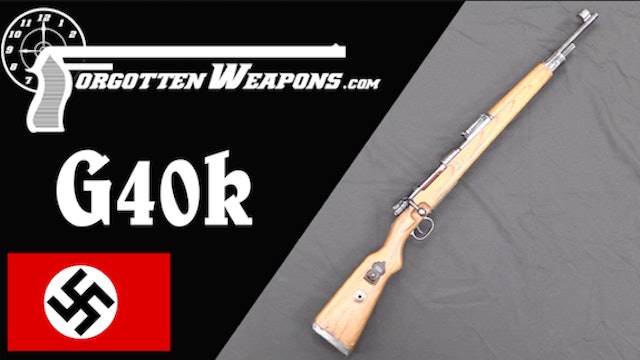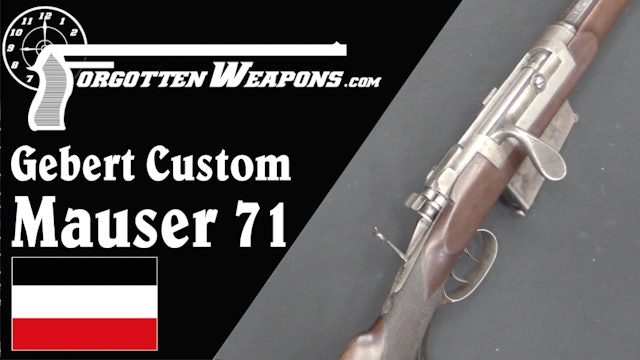-
Spanish M43: The Worst Sniper Rifle Ever Made
The standard Spanish infantry rifle from 1943 until the adoption of the CETME was the M43, an 8mm Mauser short rifle made at the La Coruña arsenal. As is fairly common, a sniper rifle variant was made form the standard rifles, with an early version made in the mid 1950s and a later model about a ...
-
Ultima Ratio: RAID and the Founding of PGM Precision
Thanks to Creedmoor Sports for sponsoring this video, and providing a couple of fine shooting mats to experiment with. Check them out for all your long range competition needs!
The Ultima Ratio was the rifle that created PGM Precision as a company. It originated with a tender for a new sniper ...
-
SSG-69: Steyr's Cold War Sniper Rifle
Make sure to also check out 9 Hole Reviews' field trial of the SSG-69 in military configuration out to 800 yards!
In the 1960s, Steyr Daimler Pusch developed a modern sniper rifle for the Austrian military (and also for commercial civilian sale). It was adopted as the SSG-69 (Scharfschützen-Ge...
-
SSG-98k: Austria Repurposes German Sniper Rifles
In the aftermath of World War Two, the Austrian Army was basically disarmed and disbanded. When it was allowed to reform in the 1950s, it needed new armaments, and in 1958 it adopted the SSG-98k as a new sniper's rifle. This replaced the leftover German K98k snipers that had been used by the smal...
-
M1903A4: America's WW2 Sniper Rifle
The United States Army entered World War Two with neither sniper rifles nor a sniper training program. As troops began to see combat, requests began to come back to the War Department that both were urgently needed. The newly-adopted dM1 Garand rifle was going to be a bit tricky to mount optics o...
-
M28/76: A Finnish Competition & Sniper Mosin
The Finns developed several difference scopes rifles in the 1930s, but none were made in large quantities, and they were not really much used during the Winter War or Continuation War. The first post-war consideration was given to a new model in 1954, but that led instead to a decision to make a ...
-
Remington M1903A4 Sniper at the Range
Today we are taking the Remington M1903A4 out to the range for some shooting. This was the standard US sniper rifle during World War Two, and I'm curious to see how one actually handles...
-
Argentina's Slightly French Model 1909 SOM Sniper
Argentina was one of the first countries to adopt Mauser rifles, with the Model 1891. These were replaced by newer Model 1909 rifles a couple decades later, and in 1913 they bought 500 telescopic sights to make sniper rifles. All of them appear to have been put on cavalry carbines like this one, ...
-
Finland's M39 PH Sniper from the Continuation War
The basic equipment of the Finnish Army came from what was left in Finland by departing Russian soldiers when Finland declared independence. As the Russians had no scoped rifles at that time, Finland didn't have any either. The Finnish Army began experimenting slowly with the concept of a scoped ...
-
L8(T) Enfield: The British Army Fails to Make a Sniper
We looked at the 7.62mm conversion of the No4 Enfield into Rifle L8 yesterday. Part of that program was an attempt to develop a new sniper rifle on the L8 platform. To this end, six good-quality No4(T) Lee Enfield sniper rifles were tested for accuracy, then made into L8 rifles and fitted with No...
-
The French FR-F2: Best of the Cold War Sniper Rifles
In 1986, the French Army adopted the FR-F2 (Fusil à Répétition F2) as its standard sniper rifle. The F2 was never manufactured new; it was an improvement made on existing FR-F1 rifle by giving them new 7.62mm NATO barrels, new flexible bipods, and thermal sleeves over the barrels. Of 6,000 FR-F1 ...
-
FR-F2 French Sniper Rifle at the Range
Today I've taken the FR-F2 to the range to try it out. I'm using the early French Army scope, an APX L806-04. This is a 3.85x optic basically modeled on the German WW2 ZF-4. It has a big simple German post reticle, and the -04 variation indicated that the BDC cam has been calibrated for 7.62mm NATO.
-
Ross WWI Sniper Rifle w/ Winchester A5 Scope
The standard Canadian sniper's rifle of World War One was the MkIII Ross fitted with a Warner & Swasey "musket sight" purchased from the United States. However, armorers in the field did create sniping rifles using other scopes - in particular the Winchester A5. The A5 was a popular commercial ri...
-
German World War One Gewehr 98 Sniper
Germany was the earliest adopter of scoped rifles in World War One, and produced more of them over the course of the war than any other power. After an initial stop-gap effort to scrounge up civilian hunting rifles, a sniper conversion program was adopted by the main German rifle factories. Germa...
-
Swiss ZfK-55 Sniper Rifle
The ZfK-55 is basically a K31 action, with a bunch of modifications to convert it into a very nice marksman's rifle. The more obvious changes are the muzzle brake (very reminiscent of the second model FG-42, which makes sense as the Swiss experimented with those rifle quite a bit after the war), ...
-
Czech vz.54 Sniper Rifle
While Czechoslovakia was a part of the eastern bloc, it did a pretty thorough job of developing its own weapons rather than use standard Russian designs. For example, the vz52 pistol, vz52, 52/57, and 58 rifles, the uk59 light machine gun, and more. Well, their military sniper rifle was closer to...
-
Swiss K31/42 and K31/43 Sniper Rifles
The Swiss experimented with scoped sniper rifles during World War II, and the results were the K31/42 and the K31/43. Only a couple thousand were made between the two models, and they were not considered particularly successful. Ultimately they were replaced by the ZfK-55 (a much better rifle for...
-
WWI Trench Mauser
As World War One stagnated into trench warfare, snipers and machine guns quickly proliferated, and exposure above the parapet of one's trench could be extremely hazardous. This leaves one with the question of, how to shoot back without risking a bullet?
One answer that was devised was to mount...
-
Mosin Nagant M91/30 PU Sniper
The Soviet Union produced more sniper rifles during WWII than any other country, and was one of very few to have a well-developed sniper program in place before the war began. Starting in the early 1930s, they developed a sniper variant of the standard M91/30 infantry rifle, with technical assist...
-
Rod Bayonet Springfield 1903 (w/ Royalties and Heat Treat)
(Note: I misspoke regarding Roosevelt's letter; he was President at the time and writing to the Secretary of War)
The US military adopted the Model 1903 Springfield rifle in 1903, replacing the short-lived Krag-Jorgenson rifle. However, the 1903 would undergo some pretty substantial changes in 1...
-
Colt Franklin: Detachable 9-Round Magazine of .45-70 in 1884
Patented in 1884 and designed by retired Civil War General William Franklin, this was an effort by Colt to win a military contract for a repeating rifle. It was a wholly new rifle (not a conversion) that operated like a Gras action, was chambered for .45-70 cartridges, and fed from a 9-round hopp...
-
The G40k: A German Experimental Mauser Carbine
In April 1940, WaPrüf 2 directed Mauser to begin development of a shortened Master carbine with a 490mm (19.3”) barrel, presumably for specialty troops. Development meandered on until July 1942, by which time just 28 rifles had been made, in two series. The first batch were numbered 3-15 and the ...
-
French Underfolding Paratrooper Rifle: MAS 36 CR39
The CR39 ("crosse repliable", or folding stock) is the paratrooper version of the MAS 36. The need for a more compact and transportable pattern was recognized almost as soon as the MAS 36 was finalized, originally for paratroops but in practice also for alpine troops. Two years were spent devisin...
-
Gebert Custom Mauser 71 with all the Bells and Whistles
Made by Carl Gebert, a master gunsmith in Munich, this custom sporting rifle exhibits all the fancy options available in the 1870s or 1880s! The base action is an 1871 Mauser, which was a single shot rifle. However, this specially made one had been modified to us a fixed box magazine holding 3 or...

























